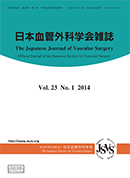Volume 23, Issue 7
Displaying 1-12 of 12 articles from this issue
- |<
- <
- 1
- >
- >|
Review Article
-
2014Volume 23Issue 7 Pages 957-963
Published: 2014
Released on J-STAGE: December 25, 2014
Advance online publication: December 10, 2014Download PDF (4540K)
Original Article
-
2014Volume 23Issue 7 Pages 964-971
Published: 2014
Released on J-STAGE: December 25, 2014
Advance online publication: December 10, 2014Download PDF (1423K)
Case Reports
-
2014Volume 23Issue 7 Pages 972-976
Published: 2014
Released on J-STAGE: December 25, 2014
Advance online publication: December 10, 2014Download PDF (1370K) -
2014Volume 23Issue 7 Pages 977-980
Published: 2014
Released on J-STAGE: December 25, 2014
Advance online publication: December 10, 2014Download PDF (1214K) -
2014Volume 23Issue 7 Pages 981-984
Published: 2014
Released on J-STAGE: December 25, 2014
Advance online publication: December 10, 2014Download PDF (1602K) -
2014Volume 23Issue 7 Pages 985-988
Published: 2014
Released on J-STAGE: December 25, 2014
Advance online publication: December 10, 2014Download PDF (1758K) -
2014Volume 23Issue 7 Pages 989-992
Published: 2014
Released on J-STAGE: December 25, 2014
Advance online publication: December 10, 2014Download PDF (1549K) -
2014Volume 23Issue 7 Pages 993-996
Published: 2014
Released on J-STAGE: December 25, 2014
Advance online publication: December 10, 2014Download PDF (1771K) -
2014Volume 23Issue 7 Pages 997-1001
Published: 2014
Released on J-STAGE: December 25, 2014
Advance online publication: December 10, 2014Download PDF (1428K) -
2014Volume 23Issue 7 Pages 1002-1006
Published: 2014
Released on J-STAGE: December 25, 2014
Advance online publication: December 10, 2014Download PDF (1539K) -
2014Volume 23Issue 7 Pages 1007-1010
Published: 2014
Released on J-STAGE: December 25, 2014
Advance online publication: December 10, 2014Download PDF (1768K) -
2014Volume 23Issue 7 Pages 1011-1014
Published: 2014
Released on J-STAGE: December 25, 2014
Download PDF (1968K)
- |<
- <
- 1
- >
- >|
